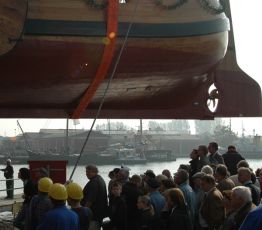Project Aim
The central aim of the North SEAfaring project was to raise the status of maritime heritage in regional and national spatial planning strategies. Hence the project referred to a creative rehabilitation, protection and development of cultural and natural landscapes and townscapes. This was accomplished through integrated spatial planning, with a focus on seafaring heritage.
Project implementation and results
Spatial development
The North SEAfaring project combined maritime heritage with regional and national spatial planning strategies by innovative solutions and ideas bringing together spatial planners and maritime heritage people.
The main achievement was that local planners from each project side, acknowledged the importance of maritime heritage in the development of their work. Therefore, spatial strategies including heritage protection measures were developed in all of the participating regions and towns.
Another final outcome is represented by reconstruction of historic maritime heritage sites in the North Sea Region, which serve as tourist attractions and support economic development.
As a social aspect both young people and unemployed were directly involved in the reconstruction. The project has also had a positive effect and benefit on the environment. Through the development of integrated spatial strategies respecting the local environment, it also led to improvements in the environment through the creative rehabilitation of derelict sites and wasteland.
Joint transnational strategy
The project partners were inspired to work hard in their own areas and make connections in a range of vertical sectors. Horizontally, many more people were interested in both the heritage aspects of the project and the spatial component than was anticipated.
Through the transnational approach, project partners of NorthSEAfaring have succeeded in gathering together traditional skills and crafts to restore historic port infrastructure such as the reconstruction of the "tjalk", a traditional vessel type in Emden (DE).
Impact of the project
Long-term achievements and policy shaping
North SEAfaring anticipated that most activities would be carried out at a local level. However, opportunity arose to cooperate with the UK government on the development of concepts of support for maritime heritage on ministerial level. Broader EU levels were influenced through European Maritime Heritage. Furthermore, transnational work with the key maritime heritage groups within the EU has raised awareness of the implications of working with spatial planners and the necessity of becoming involved as a matter of priority rather than wait for planning issue to create difficulties.
Dissemination
The website will continue to operate for dissemination of the spatial material, the raising of heritage concerns and potential solutions. All partners will continue to promote the project material and contact network within their broader spheres of influence, from national government levels to community interfaces.
The developed guidelines and examples are used as primers and toolkits for innovative North Sea spatial planning on local, regional and transnational level. |

Launch of the tjalk Emden (DE) – a vessel built by trainees and long-term unemployed
Partners Maritieme Site Oostende, BE
Autonoom Gemeentbedrijf Haven Oostende, BE
City of Emden, DE
Province of Noord-Holland, NL
Stichting Industrieel Engoedbank 'De Hoop', NL
Province of Zeeland, NL
Excelsior Trust, UK
Waveney District Council, NL
Dundee City Council, UK
LP:
Colchester Borough Council
Project Manager
Will Hawkesworth
Colchester Borough Council The Customs House, Hythe Quay
CO2 8JB Colchester
United Kingdom
Will.Hawkesworth@colchester.gov.uk
www.northseafaring.org
Tel: +44 1206 863217
Measure: 3.1
Start Date: 27 February 2004
End Date: 30 June 2007
ERDF Grant:
 1.533.388,00 1.533.388,00
Total Eligible Sum:
 3.066.776,00 3.066.776,00
|